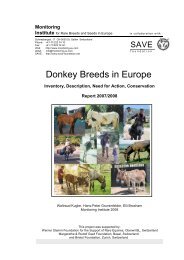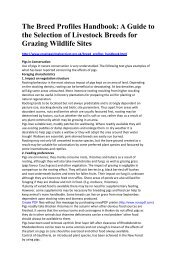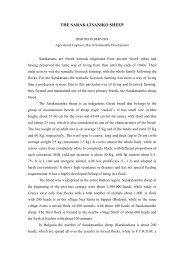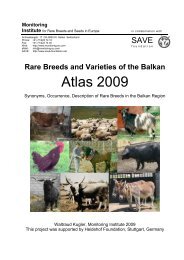The BurrenLIFE Project Farming for Conservation in the Burren ...
The BurrenLIFE Project Farming for Conservation in the Burren ...
The BurrenLIFE Project Farming for Conservation in the Burren ...
Create successful ePaper yourself
Turn your PDF publications into a flip-book with our unique Google optimized e-Paper software.
<strong>The</strong> <strong><strong>Burren</strong>LIFE</strong> <strong>Project</strong><br />
<strong>Farm<strong>in</strong>g</strong> <strong>for</strong> <strong>Conservation</strong> <strong>in</strong> <strong>the</strong> <strong>Burren</strong><br />
Brendan Dun<strong>for</strong>d, James Moran
Overview<br />
- _____________________________<br />
a brief <strong>in</strong>troduction to <strong>the</strong> <strong>Burren</strong><br />
- <strong>the</strong> role of agriculture<br />
- manag<strong>in</strong>g <strong>the</strong> heritage of <strong>the</strong> <strong>Burren</strong><br />
- <strong>The</strong> <strong><strong>Burren</strong>LIFE</strong> approach
<strong>The</strong> <strong>Burren</strong> Region (c.56,000ha, c.30,000 SAC, c. 1500ha State owned)
Boireann – rocky place, place of stone
Karren
Limestone Pavements (a priority habitat): 18,000ha <strong>in</strong> three <strong>Burren</strong> SACs (UK: 3,500ha)
<strong>The</strong> ‘lunar’ landscape of <strong>the</strong> <strong>Burren</strong>
<strong>The</strong> <strong>Burren</strong> was ‘a place densely settled and <strong>in</strong>tensively farmed’ some 4,500 years<br />
ago, at <strong>the</strong> end of <strong>the</strong> Neolithic period (Jones, 1997).
<strong>The</strong> hidden heritage of <strong>the</strong> <strong>Burren</strong> …
Goat cro
<strong>The</strong> <strong>Burren</strong> … one vast memorial to bygone cultures – Tim Rob<strong>in</strong>son
It is said that it is a country where <strong>the</strong>re is not water enough to drown a man, wood<br />
enough to hang one, nor earth enough to bury <strong>the</strong>m …
<strong>The</strong>ir cattle are very fat. <strong>The</strong> grass grows <strong>in</strong> tufts of earth of two or three foot<br />
square which lies between <strong>the</strong> limestone rocks and is very sweet and nourish<strong>in</strong>g -<br />
Ludlow (1651)
2. <strong>The</strong> role of agriculture
1317: ‘overflow<strong>in</strong>g with milk and yield<strong>in</strong>g luscious grass’<br />
1681: <strong>The</strong> <strong>Burren</strong> ‘ raises earlier beef and mutton … than any land <strong>in</strong> this k<strong>in</strong>gdom, and much<br />
sweeter by reason of <strong>the</strong> sweet herbs <strong>in</strong>termixed and distributed everywhere.’<br />
1761: ‘<strong>The</strong> sheep graze <strong>the</strong>re all w<strong>in</strong>ter without any fodder … near double <strong>the</strong> tallow of a sheep of<br />
<strong>the</strong> same size fed upon rich pasture’.<br />
1808: ‘immense numbers of sheep, <strong>the</strong> mutton of which is amongst <strong>the</strong> best <strong>in</strong> Ireland’<br />
1862: ‘fat sheep and cattle of <strong>the</strong> <strong>Burren</strong> proverbial amongst Irish agriculturists …’
<strong>The</strong> <strong>Burren</strong> SACs conta<strong>in</strong> over one quarter of <strong>the</strong> estimated 6,000ha of orchid-rich<br />
calcareous grasslands (a priority habitat) rema<strong>in</strong><strong>in</strong>g <strong>in</strong> Ireland.
Spr<strong>in</strong>g gentian
Manag<strong>in</strong>g <strong>the</strong> Heritage of <strong>the</strong> <strong>Burren</strong><br />
_
<strong>The</strong> Rural Environmental Protection Scheme (REPS)
Year 1953 1960 1970 1980 1991 2000<br />
Number 745 587 600 562 325 318<br />
Number of Farm Hold<strong>in</strong>gs, Ballyvaughan RD (Source: CSO)<br />
1400<br />
1200<br />
Number of farm workers<br />
1000<br />
800<br />
600<br />
400<br />
200<br />
0<br />
1927 1935 1945 1953 1960 1965 1970 1980* 1986* 1991* 1996**<br />
Year<br />
Number of males employed <strong>in</strong> agriculture, 1927‐1996, Ballyvaughan RD.<br />
( *males and females employed <strong>in</strong> AFF). Source: CSO
Coulter (1852): ‘<strong>the</strong> people are literally cook<strong>in</strong>g <strong>the</strong>ir food with dried fern, heath,<br />
brambles, and branches of hazel, of which <strong>the</strong>re is a scanty growth here and <strong>the</strong>re’
<strong>Farm<strong>in</strong>g</strong> <strong>for</strong> <strong>Conservation</strong> <strong>in</strong> <strong>the</strong> <strong>Burren</strong><br />
<strong>Project</strong> Budget: 2.23m euro. EU contribution:1,672,865 euro(75%)<br />
Timeframe: September 1 st , 2004 – August 31 st 2009<br />
Partners: National Parks and Wildlife Service (375,122 euro)<br />
Teagasc (169,900 euro), <strong>Burren</strong> IFA (12,600 euro)<br />
Supporters: Leader (Clare), Dept of Agriculture & Food , NUI Galway,<br />
Clare Co. Co., Galway Co. Co., <strong>The</strong> Heritage Council<br />
<strong>Project</strong> Staff: Three full-time staff:<br />
Manager, Scientific co-ord<strong>in</strong>ator, Adm<strong>in</strong>istrator
<strong>Farm<strong>in</strong>g</strong> <strong>for</strong> <strong>Conservation</strong> <strong>in</strong> <strong>the</strong> <strong>Burren</strong> – what’s it all about
<strong>Farm<strong>in</strong>g</strong> <strong>for</strong> production and <strong>for</strong> conservation…<br />
… a quality product from a quality environment
Objective: To develop a new model <strong>for</strong> <strong>the</strong> susta<strong>in</strong>able agricultural management of <strong>the</strong><br />
Habitats Directive Annex I Priority habitats of <strong>the</strong> <strong>Burren</strong>.<br />
Limestone Pavement<br />
Turloughs, Petrify<strong>in</strong>g Spr<strong>in</strong>gs, Cladium Fens<br />
Orchid rich grasslands
Threats to priority habitats
Ground-up approach (better buy-<strong>in</strong>)…<br />
Farmer and conservationist!<br />
<strong>The</strong>re is a world <strong>in</strong> <strong>the</strong> land, a farm<strong>in</strong>g world of <strong>the</strong> most sophisticated complexity and <strong>the</strong> most astute<br />
and rich memory that <strong>in</strong> <strong>the</strong> next ten years will have vanished completely. O’Donoghue (Clare Champion 11‐2‐00).
Practical solutions …<br />
versus
Flexibility of approach<br />
Book of Survey and Distribution (Sim<strong>in</strong>gton, 1641): With<strong>in</strong> <strong>the</strong> Barony of <strong>the</strong> <strong>Burren</strong>, 14 different<br />
classes of ‘pasture’ are listed, such as ‘Dwarfwood pasture’ and ‘Rockie pasture’, fur<strong>the</strong>r differentiated<br />
<strong>in</strong>to 69 subdivisions based on profitability, such as ‘Rockie pasture 1/3 profit’, ‘Rockie pasture 1/8 profit’.
Conclusions: <strong>The</strong> <strong>Burren</strong> – high nature and culture value landscape<br />
Agriculture – key to <strong>the</strong> evolution - and conservation of - this landscape<br />
<strong>Farm<strong>in</strong>g</strong> today – efficiency driven, marg<strong>in</strong>al areas often ‘set aside’<br />
<strong>Burren</strong> <strong>Farm<strong>in</strong>g</strong> – uncerta<strong>in</strong> future, needs new impetus if it is to survive<br />
<strong><strong>Burren</strong>LIFE</strong> approach largely <strong>in</strong><strong>for</strong>med and implemented by local farmers<br />
Emphasis on engagement, partnership and practical, proactive actions
<strong><strong>Burren</strong>LIFE</strong>: Serv<strong>in</strong>g <strong>the</strong> communities of <strong>the</strong> <strong>Burren</strong> – past, present and future<br />
Partnership
James Moran<br />
<strong><strong>Burren</strong>LIFE</strong>-Approach
Talk Outl<strong>in</strong>e<br />
• Public Consultation and Farm Visits<br />
• <strong><strong>Burren</strong>LIFE</strong>-Monitor Farms<br />
• Farm Plann<strong>in</strong>g Case Study<br />
• <strong><strong>Burren</strong>LIFE</strong> and Agri-Environment<br />
Schemes
Novel Approach<br />
• Farmers: How do we address <strong>the</strong> threats that face<br />
<strong>the</strong> <strong>Burren</strong><br />
• <strong>Project</strong> Partners: Support farmers to try out <strong>the</strong>se<br />
and o<strong>the</strong>r solutions on <strong>the</strong>ir farms.<br />
• Toge<strong>the</strong>r: Monitor <strong>the</strong> impacts to see how<br />
effective <strong>the</strong>se changes have proven to be.<br />
• Result: Bluepr<strong>in</strong>t <strong>for</strong> susta<strong>in</strong>able farm<strong>in</strong>g <strong>in</strong> <strong>the</strong><br />
<strong>Burren</strong>.<br />
• Implemented on <strong><strong>Burren</strong>LIFE</strong> monitor farms.
Public Consultation and Farm Visits<br />
• >50 farm visits<br />
• In<strong>for</strong>mal, opportunity <strong>for</strong> <strong>the</strong> <strong>Project</strong> Team to witness<br />
<strong>the</strong> diversity of systems, op<strong>in</strong>ions and ideas that exist <strong>in</strong><br />
<strong>the</strong> region.<br />
• Allow <strong>the</strong> farmer to learn more about <strong>the</strong> purpose and<br />
objectives of <strong>the</strong> <strong>Project</strong> and how he / she might<br />
contribute to it.<br />
• Visits began with <strong>the</strong> implementation of a farm-scop<strong>in</strong>g<br />
questionnaire. It was designed to establish basic facts<br />
regard<strong>in</strong>g <strong>the</strong> prevail<strong>in</strong>g farm system.<br />
• Basel<strong>in</strong>e environmental surveys of priority habitats.<br />
• <strong><strong>Burren</strong>LIFE</strong> monitor farm selection (Target: 25 farms).
Farm Plann<strong>in</strong>g<br />
• Basel<strong>in</strong>e <strong>in</strong><strong>for</strong>mation from questionnaire,<br />
environmental assessment, aerial photographs, OS<br />
maps and REPS plan.<br />
• Example of <strong><strong>Burren</strong>LIFE</strong> Farm Plann<strong>in</strong>g<br />
– 140 Ha suckler beef farm<br />
– 35 cows and 1 Bull<br />
– Weanl<strong>in</strong>gs sold <strong>in</strong> autumn<br />
– 4 Replacement Heifers<br />
– REPS
Base Map
• High level of complexity<br />
• Flexibility <strong>in</strong> management<br />
• Farmer <strong>in</strong>put
BurrrenLIFE Farm - Objectives<br />
• Farm situation: Limited available<br />
manpower, very restricted access and rapid<br />
levels of scrub encroachment.<br />
• Overall objective: Ma<strong>in</strong>ta<strong>in</strong> or <strong>in</strong>crease<br />
graz<strong>in</strong>g pressure<br />
• Enhance access <strong>in</strong>volv<strong>in</strong>g strategic removal<br />
of passages of scrub.<br />
• Introduction of concentrate feedstuffs to<br />
replace silage.<br />
• Ease restrictions on summer graz<strong>in</strong>g.<br />
• Labour efficient system.
Monitor<strong>in</strong>g Actions<br />
• Environmental – effect of actions on priority<br />
habitats<br />
• Agricultural – effect of action on animal health<br />
and condition<br />
• Socio-economic – cost<strong>in</strong>g of actions and effects<br />
on farmers <strong>in</strong>come and time
<strong><strong>Burren</strong>LIFE</strong> and Development<br />
of Agri-enviromental<br />
Schemes<br />
• Many actions specific to <strong>Burren</strong><br />
• Approach = Bluepr<strong>in</strong>t <strong>for</strong> o<strong>the</strong>r areas<br />
• Key aspects:<br />
– Partnership<br />
– Increased farmer participation and decision mak<strong>in</strong>g<br />
– Flexibility of approach (results driven)<br />
– High biodiversity requires diversity of management<br />
– Research and monitor<strong>in</strong>g


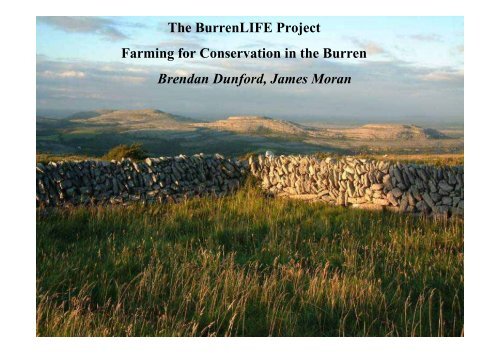
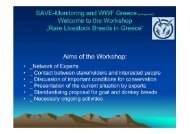
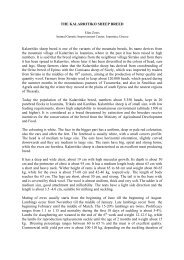
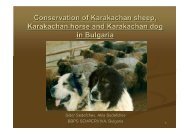
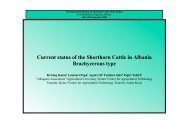


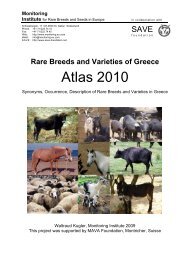
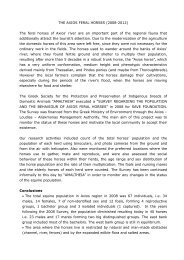
![Busha AL 2013 [Kompatibilitätsmodus] - Agrobiodiversity-Net](https://img.yumpu.com/35252125/1/190x135/busha-al-2013-kompatibilitatsmodus-agrobiodiversity-net.jpg?quality=85)
